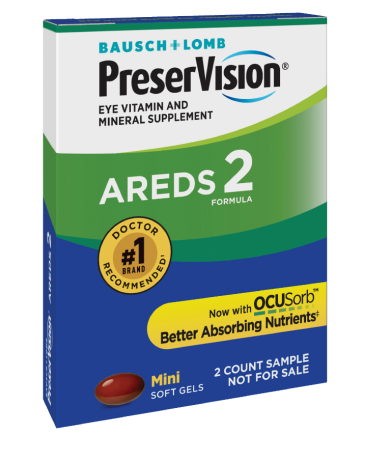Lutein + Zeaxanthin showed an approximate 20% beneficial effect vs beta-carotene, as well as no increased risk of lung cancer in patients who were former and current smokers.1
20 Years of AMD Leadership
Age-Related Eye Disease
Study (AREDS)
NEI researchers concluded their first
five-year clinical Age-Related Eye Disease
Study (AREDS).
6,351
Study participants ages 55
to 80 years, with and
without AMD.
19%
Reduced risk of moderate
vision loss after five years.
25%
Reduction in risk of AMD
progression in those with
moderate-to-advanced
AMD.
10 Years
Participants showed
continued effects at
study follow-up in 2006.
2nd Age-Related Eye
Disease Study
Based on new learnings around AMD, the
NEI researchers sought to improve the
original AREDS formula.
The result was an updated formula that replaced beta-carotene with lutein and zeaxanthin, since new research suggested an association between beta-carotene and an increase in the risk of lung cancer among those with a history of smoking.2
4,203
Study participants ages 50
to 85, with AMD.
82
Clinical centers across the
U.S.
5 Years
Length of AREDS2 study.
18%
Reduced risk of
progressing to advanced
AMD, compared to
patients taking the
original AREDS
formulation.1
- No clinically statistically significant differences in AEs between treatment groups. Post-hoc subgroup analysis
- Johnson EJ. Curr Opin Clin Nutr Metab Care. 2010;13(1):28-33
1. No clinically statistically significant differences in AEs between treatment groups. Post-hoc subgroup analysis
2. Johnson EJ. Curr Opin Clin Nutr Metab Care. 2010;13(1):28-33
The NEI publishes the results of its 10 Year Follow-on
study1, using Bausch + Lomb’s PreserVision®
AREDS 2 Formula Eye Vitamins in the last 5
years of study.
The NEI’s AREDS2 10 year Follow-on study
further validated the original findings about
the AREDS2 formulation with 80mg of zinc.
The study also provided support for the
continued benefit of lutein and zeaxanthin vs.
beta-carotene.
6,360
Eyes in the NEI AREDS2 10
year follow-on study
10%
Reduction in progression
to late AMD
20%
Reduction in progression
to neovascular AMD
10
10 Years of sustained
results
- Chew, Emily Y., et al. JAMA Ophthalmol. Published online June 2, 2022. doi:10.1001/jamaophthalmol.2022.1640
The NEI recommends taking a vitamin formula that contains the exact nutrients based on the AREDS2 study for helping to reduce the risk of progression in moderate-to-advanced AMD.
| Nutrient | Amount (per day) | Percent Daily Value |
|---|---|---|
| Zinc | 80 mg | 727% |
| Lutein | 10 mg | ** |
| Zeaxanthin | 2 mg | ** |
| Vitamin C | 500 mg | 556% |
| Vitamin E | 180 mg | 1200% |
| Copper | 2 mg | 222% |
* Percent Daily Values (DV) Based on a 2000-calorie diet
**Daily value not established
Findings
No significant side effects were observed in patients who received a formula with 80 mg zinc per day.
Therefore, the NEI continues to recommend 80mg zinc per the results of the AREDS2 10 year follow-on study.
Data indicates no statistical beneficial effect in EPA+DHA towards reducing the risk of progression to late AMD in the AREDS2 formulation.
- Chew, E.Y, et al. 2022. The Long-term effects of adding Lutein-Zeaxanthin and Omega-3 Fatty Acids to the AREDS Supplements on Age-Related Macular Degeneration. [Unpublished Manuscript] The AREDS2 Research Group/National Eye Institute.
PreserVision® Samples
for Your Appropriate Patients
Request Samples
*These statements have not been evaluated by the Food and Drug Administration.
These products are not intended to diagnose, treat, cure or prevent any disease.

‡ Based on AUC of Lutein and Zeaxanthin compared
to original PreserVision AREDS 2 Soft Gel.
*These statements have not been evaluated by the Food and Drug Administration.
These products are not intended to diagnose, treat, cure or prevent any disease.
Text Size:


